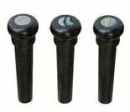|
Acoustic Guitar Bridge Pins
Materials for Bridge PinsWhile most guitars come with plastic bridge pins already in place, upgrading your acoustic guitar bridge pins to those made of bone, buffalo horn, ebony or even fossilized walrus ivory can go a long way towards improving your guitar’s tone. Different bridge pins can even change your guitar’s pitch, causing the guitar to become more treble or bass-oriented. If you are replacing plastic bridge pins, pins made of tusq or bone will add treble to your guitar while improving your guitar’s clarity and volume. On the other hand, ebony bridge pins will add bass and warmth to your guitar’s tone as well as increasing its volume and sustain. Buffalo horn bridge pins do the exact same job as regular bone pins – only they look a good deal cooler. If you want to get really specialized, you can look into walrus jawbone, walrus ivory or mammoth ivory. Replacing your plastic bridge pins with walrus jawbone will provide the same richness as bone, only with better overtones and more rounded harmonics while walrus ivory will go far in increasing your guitar’s volume, sustain and clarity. Mammoth ivory bridge pins increase the richness of the guitar and extend the reach of your harmonics in addition to adding volume and sustain. There is no one type of material that can be recommended for pins. The trick is to experiment with the different materials until you find a tone and texture that suits your tastes. So have fun trying out the different types and materials, the tone you are looking for is just a bridge pin away. Removing Your Bridge PinsWatch this video on how to effectively remove the bridge pins on your guitar.
TABLE OF CONTENTS: Guitar Parts & AccessoriesAcoustic Guitar Amps| Acoustic Guitar Bridge| Acoustic Guitar Bridge Pins| Acoustic Guitar Case| Acoustic Guitar Flight Case| Acoustic Guitar Kits| Acoustic Guitar Microphone| Acoustic Guitar Neck| Guitar Pics| Guitar Pickguards| Acoustic Guitar Pickups| Acoustic Guitar Saddle| Acoustic Guitar Stand| Acoustic Guitar Strap| Acoustic Guitar Strings| Acoustic Guitar Tuner| Acoustic Guitar TuningReturn to Acoustic Guitar Parts Go to Best Acoustic Guitars
|











